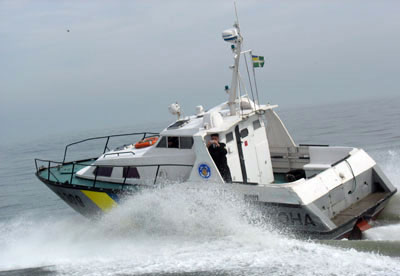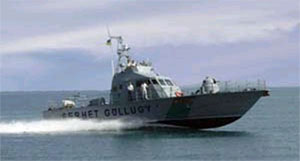26.10.10
Text: RusNavy.com, Evgeny V. Arkhipovsky
"A man-of-war is the best ambassador"
| Tell a friend | Print version |
|---|
Home / Russia / The National Security Strategy / Analytics / Naval Cooperation with Ex-Soviet Republics / Part III. Friends or competitors?
Part III. Friends or competitors?
Oliver Cromwell
In the list of ex-Soviet republics, Ukraine holds a specific position. This distinction concerns almost all areas of policy and economy. The point is that Ukraine inherited more than substantial economic and defense potential after the breakup of the Soviet Union. There is no use to name all those enterprises which had been effectively working for Soviet defense industry and then were handed over to Ukraine. Suffice it to say that their capabilities are well enough to provide Ukraine's armed forces with all required equipment; national navy is not an exception. The question is both shipbuilding component and advanced naval arms.
Nevertheless, after the collapse of the USSR there were strong trends among Ukrainian and Russian experts to preserve scientific and production co-operation. That was obvious and logic from the viewpoint of those who had appraised all advantages of such stable relations. Theoretically, the abovementioned scientific and production co-operation could have worked normally even though its components were located in already different countries.
But – alas! – the "divorce" of formerly united republics went upon another scenario, and previously friendly republics had become bitter enemies. This "divorce" resulted in several hot spots capable to smoke the whole world once somebody blows the fire. The then-policy being realized in nationalism of Kravchuk and Yeltsin's words like "take sovereignty as much as you wish" has led to deplorable consequences. Russia and Ukraine ran every which way, and now we have to use imagination while talking of any military technical cooperation between these countries.
We are not going to talk neither about what impact had the partition of Soviet Black Sea Fleet on Russia and Ukraine, nor about combat capabilities of ships became Ukrainian after carving of the fleet. It is rather interesting to evaluate the concepts of Ukrainian naval organization, since these concepts directly affect practicability of military technical cooperation.
Shortly after the breakup of the Soviet Union, new country Ukraine issued a document named "Naval Shipbuilding Concept of Ukraine". That concept described methods of equipping Ukrainian Navy with ships and arms systems. There were three methods mentioned.

Ukrainian-built boat Kalkan.
First: use of arms and technical assets available at Ukrainian arsenals after their upgrade or modernization.
Second: arms import and production of foreign arms under license.
Third: development and production of national arms systems.
Long storage periods of arms at arsenals and modernization experience showed that they can be used only in near-term prospect. Simply speaking, the first method was good to close holes in Ukrainian armed forces only at the stage of their foundation, not more. This method has no long-term prospects.
Arms import is – first – expensive, and – second – unreliable. When emerges the risk of cutting off deliveries or post-sale maintenance due to political reasons, this implies unreliability of any imported weapon.
Thus, the most prospective way is the third method. Orientation on national arms development and production, that's the "Ukrainian policy" in this regard. The complex analysis of the first and the second methods hints that the full-scale naval arms cooperation between Russia and Ukraine is impossible in concept.

Ukrainian-built multipurpose patrol craft Grif-T.
Presently, since the rise of Party of Regions led by Viktor Yanukovich to power, it has been much said that Ukraine's turn to Russia is inevitable and full-scale co-operation (including military technical one) will develop rather soon than later.
So far, such optimistic outlooks are groundless. The key feature of Ukrainian statehood is instability. Along with that, there is no reason to believe that current Ukraine's administration follows entirely pro-Russian policy. Anyway, there's an array of indicators showing action tendency of Ukrainian authorities. One of these indicators is state language law, i.e. adoption of Russian as an official language. So far, this issue has got nowhere (and even Ukrainian politicians themselves point at this), Party of Regions loses favor in its Crimean "barony", so in such situation there is no point to expect changes in Ukraine's policy which could bring full-scale military technical cooperation with Russia.
Excerpt for purely political reasons wherefore such cooperation is next to impossible, there are some economic ones. The fact is that the Ukraine's piece of Soviet defense industry is self-sufficient. As of naval component, Ukraine has all kinds of capabilities – shipbuilding, arms, and so forth. Ukraine and Russia are destined to be competitors in naval arms exports; it looks like there's no other way in current situation. At least, it is hard to dispute such assertion here and now.
Recently, there have been numerous hints in media that Russian-Ukrainian relations tend to become warmer. Nonetheless, a joyride of the two presidents on Soviet-made cars, adoption of Russian as a local language in one of Ukrainian regions, and access to aviation training center near Yevpatoriya (NITKA, Crimea) are not enough to lie at the root of such far-reaching conclusions. All those are not more than hints which are painstakingly interpreted by media gurus, mostly – gossipmongers. They transform rumors into speculative theories and even begin to believe in them. But when reality turns its back, another rumor is put out and becomes a basis of subsequent forecast…
Read more
Contents
Part I. Who and What
Part II. Non-geographical policy or non-political geography
Part III. Friends or competitors?
Part IV. Delicate hints
Part V. Naval cooperation: geography, economy, or… policy?



